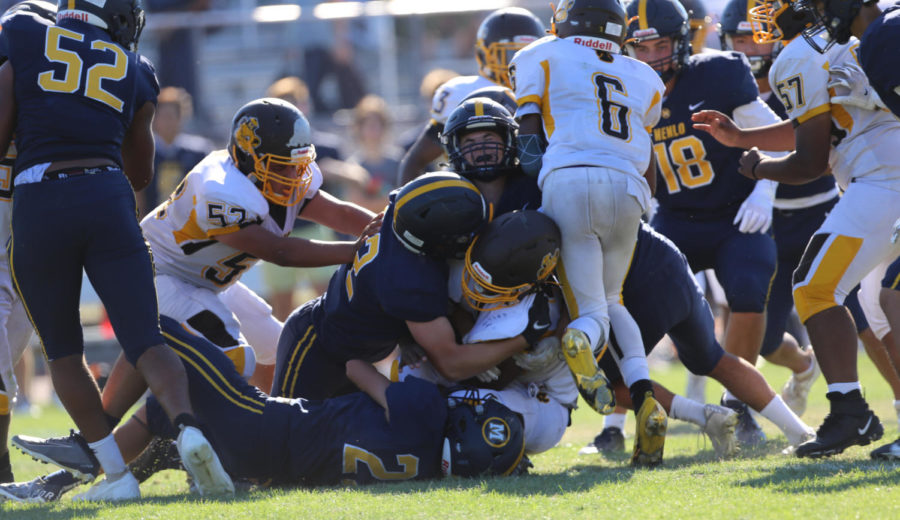CTE Risks: Why Football Players Should Reconsider Their Career Paths
September 22, 2021
Menlo varsity football players Alec Jabal, Sam Randal and Alex Levitt combine for a tackle against Mission High School. Photo courtesy of Eli Housenbold.
It’s no secret that football is a dangerous sport. Grown, 250+ pound men running into each other at top speed is not what comes to mind when defining safety.
But for many players, the injury was worth the risk. They were willing to break their arm because they knew it would heal eventually. They knew that a torn ACL was serious, but not something that couldn’t be fixed. But newer research reveals the serious threat of long-term brain injuries, and more and more football players are starting to reconsider their career path.
It seems intuitive. How could kids banging their heads into each other as hard as possible be safe? Yet, it wasn’t until 2016 when the NFL recognized a connection between Chronic traumatic encephalopathy (CTE) and playing professional football. This led to many great NFL players retiring because of the risk of severe head trauma. Players like Chris Borland and Joshua Perry chose a life with their families and better long-term brain health over a long NFL career because of repeated concussions. Many other current players continue to weigh the costs and benefits of playing football. For some players, making millions and risking a shorter life is worth a life without football. However, many players do not think the consequences of CTE — such as depression or suicidal thoughts — are worth it.
Of course, there remain those who are dubious of CTE. Okay, a few NFL players are scared of concussions, so what? It turns out that concussions are a big deal for a large percentage of football players at any level of football. In a study done by Dr. Ann Mckee, a leading researcher at Boston University for CTE risk in football, 177 out of 202 deceased former football players were diagnosed with CTE. Furthermore, 110 out of the 111 NFL players studied, 48 out of the 53 college players studied and 3 out of the 14 high school football players studied were diagnosed with CTE.
These results should heavily alarm any parent, athlete or coach near the sport and may mean the beginning of the end of football. In 2009, according to the National Federation of StateHigh School Associations, there were over 1.1 million high school football players in America, and around a decade later there were just over 1 million — a decrease of 30,000 from the previous year. This number is not some coincidence. As more and more research reveals the ties between football and long-term head trauma, players’ parents become more and more concerned with letting their children risk the health of their undeveloped brains.
It’s undeniable that the fate of the NFL and football mostly lies in the hands of parents. As more and more parents pull their children from football, the number of players feeding into the higher levels of football decreases. Parents of young children have no reason to let their child play football and risk the health of their brain for later on in life. According to a 2017 Harvard study, the rate of injury in the NFL is 3.4 times higher than the rates of Major League Baseball, the National Basketball Association, the National Hockey League and the Union of European Football Associations combined. Additionally, the rate of concussions is 6.9 times higher than the rate of those leagues combined. It seems obvious that it is in a parent’s best interest to expose their kid to safer sports like baseball or basketball, and this trend should continue as more and more research shows the risk of playing football. In Dr. Mckee’s study, 3 out of 14 high school football players were diagnosed with CTE. If the risk of CTE for high school football players is even close to 1%, there is no reason high school and little league athletes should risk even the slightest chance at severe head trauma later in life.
Many Menlo students are subject to the same trends. Senior Ryan Schaefer attributes concussions as one of the main reasons he doesn’t play high school football because he does not want the nasty effects that come later in life. He explained that if he wanted to play, his parents would not support his decisions because of how dangerous concussions are. He did, however, say he would consider playing if there was no risk of long-term head trauma.
Senior Robbie Doll also quit the varsity football team mid-season largely due to his fear of lasting head trauma. “I noticed this year particularly that my head was hurting really bad for really long periods of time. I knew that if I kept trying to go at football, my headaches would ramp up and I could suffer larger brain damage,” Doll said. He also noted that the way he played football allowed for more brain injuries. “I wasn’t strong enough to use my body to push other people and I had to use my face mask and ultimately my head to stay in the fight,” he said.
Athletes like Schaefer and Doll continue to change the football trajectory. From the NFL all the way down to high school football, players are electing to walk away from the sport and preserve their brains. If the NFL does not take serious action to protect players’ brains, football as we know it will fade into history.
